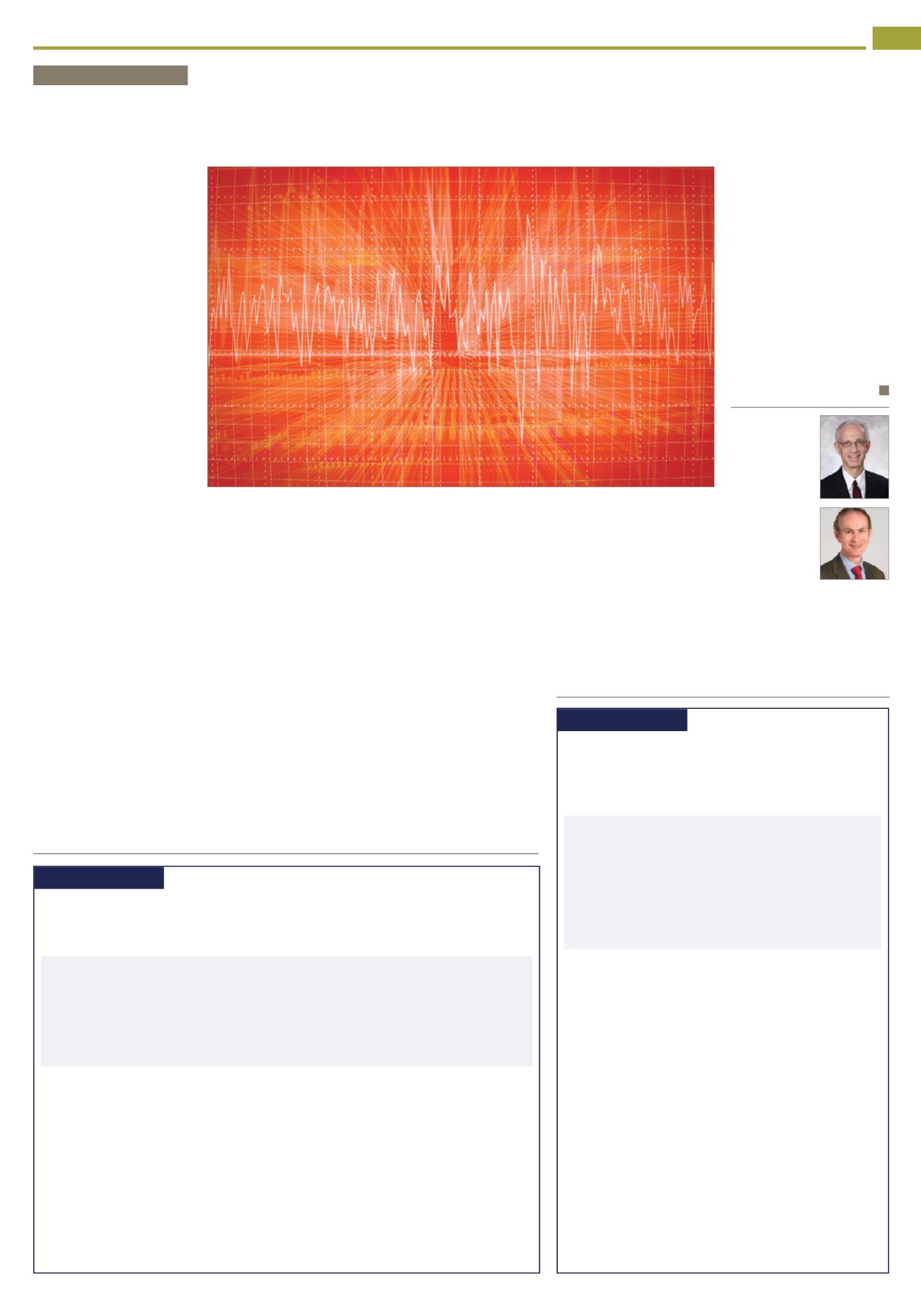

JOURNAL SCAN
LGE provides incremental prognostic information over serum biomarkers in
AL cardiac amyloidosis
JACC: Cardiovascular Imaging
Take-home message
•
A retrospective analysis was conducted of the prognostic value of cardiac magnetic resonance (CMR) late gado-
linium enhancement (LGE) in the diagnosis of amyloid light-chain (AL) amyloidosis. In total, 76 patients with AL
amyloidosis confirmed by histology underwent CMR LGE imaging. LGE was reported as global, focal patchy, or none.
Over the course of 34.4 months, 40 patients died and global LGE correlated positively with all-cause mortality (HR,
2.93; P < 0.001). In multivariate analysis with biomarker staging, global LGE still showed a significant association
with increased mortality (HR, 2.43; P = 0.01).
•
Global LGE on CMR is a helpful prognostic indicator in patients with AL cardiac amyloidosis.
OBJECTIVES
This study sought to determine the prognostic
value of cardiac magnetic resonance (CMR) late gadolinium
enhancement (LGE) in amyloid light chain (AL) cardiac
amyloidosis.
BACKGROUND
Cardiac involvement is the major determinant of
mortality in AL amyloidosis. CMR LGE is a marker of amyloid
infiltration of the myocardium. The purpose of this study was
to evaluate retrospectively the prognostic value of CMR LGE
for determining all-cause mortality in AL amyloidosis and to
compare the prognostic power with the biomarker stage.
METHODS
Seventy-six patients with histologically proven AL
amyloidosis underwent CMR LGE imaging. LGE was cat-
egorised as global, focal patchy, or none. Global LGE was
considered present if it was visualised on LGE images or
if the myocardium nulled before the blood pool on a cine
multiple inversion time (TI) sequence. CMR morphologic and
functional evaluation, echocardiographic diastolic evalua-
tion, and cardiac biomarker staging were also performed.
Subjects’ charts were reviewed for all-cause mortality. Cox
proportional hazards analysis was used to evaluate survival
in univariate and multivariate analysis.
RESULTS
There were 40 deaths, and the median study follow-
up period was 34.4 months. Global LGE was associated with
all-cause mortality in univariate analysis (hazard ratio = 2.93;
P < 0.001). In multivariate modeling with biomarker stage,
global LGE remained prognostic (hazard ratio = 2.43; P = 0.01).
CONCLUSIONS
Diffuse LGE provides incremental prognosis over
cardiac biomarker stage in patients with AL cardiac amyloidosis.
LGE Provides Incremental Prognostic Information Over
Serum Biomarkers in AL Cardiac Amyloidosis
JACC Car-
diovasc Imaging
2016 May 11; [EPub Ahead of Print],
SJ Boynton, JB Geske, A Dispenzieri, et al
JOURNAL SCAN
Right ventricular function in peripartum
cardiomyopathy is associated with left
ventricular recovery
Circulation: Heart Failure
Take-home message
•
The authors evaluated 100 peripartum cardiomyopathy patients (LVEF
<45% within 13 weeks) to determine if RV function was associated with
LV recovery (LVEF ≥50% at 1 year) and clinical outcomes. LV recovery
was attained in 75%, and 13% had LVEF of ≤35% or major adverse events.
Right ventricular fractional area change was independently associated
with LV recovery.
•
In this cohort of pregnancy-related cardiomyopathy patients, right ven-
tricular function assessed through right ventricular fractional area change
was independently associated with LV recovery.
BACKGROUND
Peripartum cardiomyopathy has variable disease progression and
left ventricular (LV) recovery. We hypothesised that baseline right ventricular (RV)
size and function are associated with LV recovery and outcome.
METHODS AND RESULTS
Investigations of Pregnancy-Associated Cardiomyopathy
was a prospective 30-centre study of 100 peripartum cardiomyopathy women
with LV ejection fraction (LVEF) <45% within 13 weeks after delivery. Baseline RV
function was assessed by echocardiographic end-diastolic area, end-systolic
area, fractional area change, tricuspid annular plane excursion, and RV speckle-
tracking longitudinal strain. LV recovery was defined as LVEF of ≥50% at 1 year,
persistent severe LV dysfunction as LVEF of ≤35%, and major events as death,
transplant, or LV assist device implantation. RV measurements were feasible
for 90 of the 96 patients (94%) with echocardiograms available. Mean baseline
LVEF was 36 ± 9%. RV fractional area change was <35% in 38% of patients. Of
84 patients with 1-year follow-up data, 63 (75%) had LV recovery and 11 (13%)
had LVEF of ≤35% or a major event (4 LV assist devices and 2 deaths). Tricuspid
annular plane excursion and RV strain did not predict outcome. Baseline RV
fractional area change by multivariable analysis was independently associated
with subsequent LV recovery and clinical outcome.
CONCLUSIONS
Peripartum cardiomyopathy patients had a high incidence of LV
recovery, but a significant minority had persistent LV dysfunction or a major clini-
cal event by 1 year. RV function per echocardiographic fractional area change at
presentation was associated with subsequent LV recovery and clinical outcomes
and thus is prognostically important.
Right Ventricular Function in Peripartum Cardiomyopathy at Presentation
Is Associated With Subsequent Left Ventricular Recovery and Clinical
Outcomes
Circ Heart Fail
2016 May 01;9(5)e002756, LA Blauwet, A Delgado-
Montero, K Ryo, et al.
MY APPROACH
The evaluation of restrictive cardiomyopathy
BY DR CRAIG R ASHER AND DR ALLAN L KLEIN
R
estrictive cardiomyopathy
(RCM) was defined as a
myocardial disease of un-
known origin based on the WHO
classification of 1980. Newer
groupings of cardiomyopathy (CM)
include the AHA classification,
which distinguishes primary cardiac
from systemic conditions, and the
MOGE(S) system, which provides a
detailed patient-specific description
of (M) morphofunctional, (O) organ
involvement, (G) genetic inherit-
ance, (E) etiologic cause, and (S)
stage of heart failure.
Nonetheless, the term RCM is
still common vocabulary used to
represent a heterogeneous group
of disorders that arise from endo-
myocardial or myocardial disease
resulting in a predominant disorder
of advanced diastolic dysfunction.
The differential diagnosis of these
disorders includes isolated cardiac
diseases and multisystem infiltrative
or storage disorders. The prototype
of RCM is cardiac amyloidosis (CA).
An important distinction to make
prior to pursuing the work-up of
RCM is to recognise that this term
is not synonymous with restrictive
physiology (RP) or a restrictive fill-
ing pattern. That is, RP can occur
in conditions other than RCM, and
RCM can occur without RP. RP
refers to the presence of a high-left
or right-sided filling pressure and
poor chamber compliance. RP can
occur with numerous conditions,
some of which include atrial fibril-
lation, constrictive pericarditis, stiff
left atrium syndrome, and coronary
artery disease. It is important to
distinguish RCM from constrictive
pericarditis since the latter may be
treated surgically.
RCM is usually suspected based
on clinical presentation of heart
failure, increased left ventricular
wall thickness (WT), and abnormal
diastolic function. CA is the most
commonly encountered RCM, so
testing should be targeted toward
determining its presence. Other rare
forms of RCM can be sought if CA
is excluded. Since echocardiography
is an initial diagnostic tool for heart
failure patients, a differential diag-
nosis of pathologically increasedWT
should be considered and most often
includes myocyte hypertrophy (hy-
pertension, hypertrophic cardiomyo-
pathy), myocardial storage (Fabry’s,
haemochromatosis), or inflamma-
tory (sarcoidosis) or infiltrative dis-
orders (CA). Concurrent with the
echocardiographic interpretation of
increased left ventricular WT, the
electrocardiogram should be viewed
for low voltage or voltage-mass mis-
match, a feature that is consistent
but not specific for CA.
Classical features of CA by
echocardiography include biven-
tricular increased WT without cav-
ity dilation, a “granular sparkling”
appearance, biatrial enlargement,
thickened valves and atrial septum,
pericardial effusion, pulmonary
hypertension, and advanced, often
grade 3, diastolic dysfunction with
an elevated mitral E/A ratio (>2),
short deceleration time (<150 ms),
very low tissue Doppler annular ve-
locities (<6 cm/s), and an elevated
mitral E/e’ ratio (>15). Systolic
anterior motion of the mitral valve
may uncommonly occur with CA.
All patients with suspected CA
should have analysis of longitudinal
strain looking for the characteristic
apical-sparing pattern, which is not
typical of most other RCMs.
With a suspected diagnosis of CA
based on clinical history, electrocar-
diography, and echocardiography
with an apical-sparing pattern,
confirmatory testing should be
performed. Laboratory testing in-
cludes: serum and urine protein
electrophoresis and immunofixation;
serum-free light chains (K:L ratio);
and transthyretin (TTR), often with
complementary bone marrow bi-
opsy. Cardiac MRI and 99mTc are
increasingly useful to assess alter-
native diagnoses and discriminate
between AL (primary amyloidosis)
and TTR CA. Tissue or cardiac bi-
opsy can be done selectively when
the diagnosis remains equivocal or
as mandated for trial inclusion.
RCM should not be considered a
futile diagnosis. Specific diagnosis
is crucial, especially among amyloid
subtypes (AL; TTR wild-type and
mutant). Heart failure management
differs from conventional treatment.
Advocacy groups including theAmy-
loid Foundation, genetic counselling
(for familial amyloid), clinical trials,
and local and national referral cent-
ers to haematology and cardiology
experts are encouraged.
Craig R Asher MD
is cardiologist at
Cleveland Clinic
Florida, Weston.
Allan L Klein MD
is director of
the Centre for
the Diagnosis
and Treatment
of Pericardial
Diseases
and a staff cardiologist in the
Section of Cardiovascular
Imaging, Department of
Cardiovascular Medicine,
Heart & Vascular Institute of
Cleveland Clinic, Cleveland.
MYOCARDIAL DISEASE
VOL. 1 • No. 1 • 2016
5

















